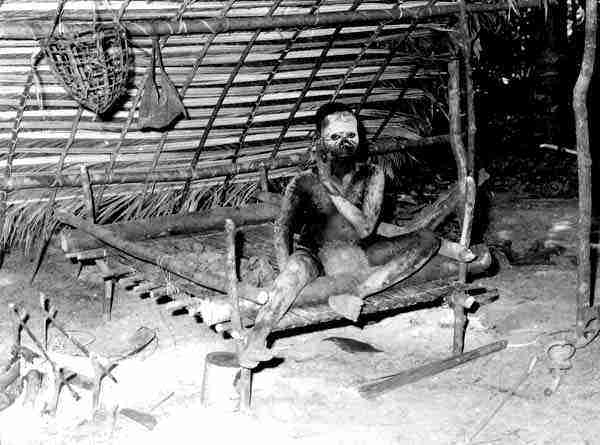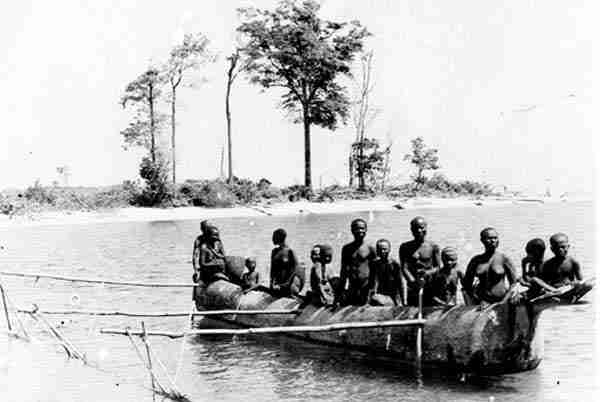Introduction
This chapter deals with Great Andamanese society as it was - or is thought to have been - before the fateful year of 1858, of Onge society as it was before the no less fateful 1950s and of Sentineli and Jarawa society as it is thought to be today still. In short: with traditional Andamanese society. As far as the Great Andamanese are concerned, information on life during the old days reached outside investigators only through the uncertain filter of old peoples' dimming memories. They remembered and retold the talk of their parents at the campfires of their youth. Old peoples' ramblings though they be, they can still shed light on a society of ancient traditions.
Rather less remote are the memories of the old days among the Onge. Since the two societies were sampled half a century to a century apart and by totally different sets of researchers - British colonial administrators there, Indian anthropologists here - it is difficult indeed to reconcile the two sets of accounts and to establish which differences are real and which merely apparent.
6.1 Local groups, tribes and septs
Social life among traditional Andamanese centred on something called, for want of a better word, the local group. This was a village community, albeit a highly nomadic one. It was in their local group that the Andamanese found peace and a secure place in the world, this was where they felt at home. Membership of a tribe had no practical importance; traditional Andamanese had few if any peaceful dealings with people from outside their own immediate neighbourhood. In most cultures, the family fulfils the emotional and physical functions that in Andamanese society were taken up by the local group. Children were readily adopted away from their parents, descent by blood did not interest anyone much and clans were quite unknown. Children were not expected to show more respect to their parents, real or adopted, than they had to show to all older people. It was age that demanded respect above all else.
Local groups were essentially nomadic, Aryoto somewhat more so than Eremtaga. The groups moved from place to place, wherever the most abundant seasonal food supply could be found, spending only the rainy season in the main camps. Rarely staying at one place outside the main camp for longer than a few weeks, each group remained strictly within its own tiny hunting territory. Any trespassing, let alone poaching, on the land of a neighbouring group would have led to immediate and serious problems. Just how ancient the local groups, their regular trails and campsites could be is shown by the kitchen midden that dots the Andamanese countryside. These are heaps of domestic refuse accumulated when a local group occupied the same site for a period of time year after year for countless generations. The midden are our only source of reliable information about the pre-1858 Andamanese and we shall look more closely at their evidence when we deal with the prehistory of the islands.
Midden were not just piles of domestic refuse that became useful platforms on which to build camps when they had reached a certain size. Their size also reflected the hunting and gathering prowess of the owning group and as such were a source of local pride, serving as a unmistakable markers to the surrounding hunting territory. The symbolic value of a large midden was further strengthened by a link to the group's ancestors by the custom, especially among Onge, to bury their dead or some bones from them under their communal huts, i.e. in the midden. Local pride in their kitchen-midden faded among the Great Andamanese after the 1860s and among Onge after the 1920s with the introduction of the dog. Dogs allowed even the most inept hunter to catch more than enough pigs and made the bow and arrow almost redundant. We find here that helping a primitive group become more efficient can destroy pride in its achievements, undermining the self-confidence necessary for long-term survival.
The size of local groups has been estimated at between 30 and 50 men, women and children. Each was made up of a few families consisting of father, mother and their unmarried children at the core with unmarried older spinsters and bachelors, widows and widowers and the occasional waif (Heimatlose) and stray (Verirrte) on the fringe. The average group owned a territory of around 40 sq.km (16 sq.miles) while the average tribe consisted of 10 local groups. People were free to leave their own group to take up residence with another and this seems to have been quite a common occurrence. Newly-weds could take up residence wherever they wished: at the local group of the bride or the bridegroom or with any other local group that would accept them. Such movement between friendly local groups was easy but it was normally limited to neighbouring groups. Emigration outside the neighbourhood may have taken place in the old days but must have been rare. A crossing from Aryoto to Eremtaga or across tribal borders would have been unthinkable.
Several communities at peace with each other and connected by ties of friendship and matrimony, whose members knew and trusted each other and whose ancestors over many generations had done likewise, formed a higher-level grouping, the sept. Social contacts within a sept were frequent and close. Groups met for feasting, dancing and the exchange of gifts, while children were often adopted out to other local groups within the sept where their biological parents could visit them.


